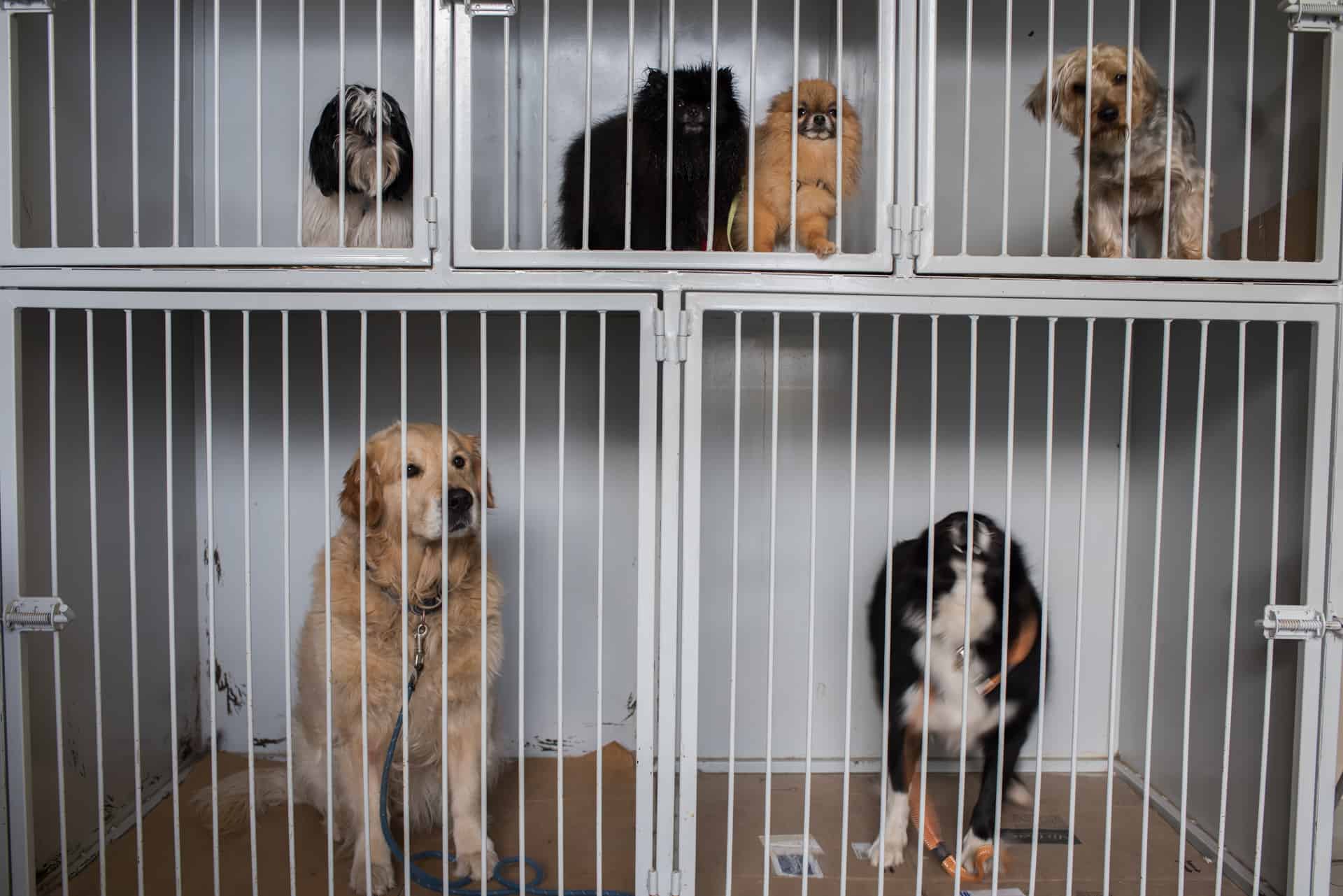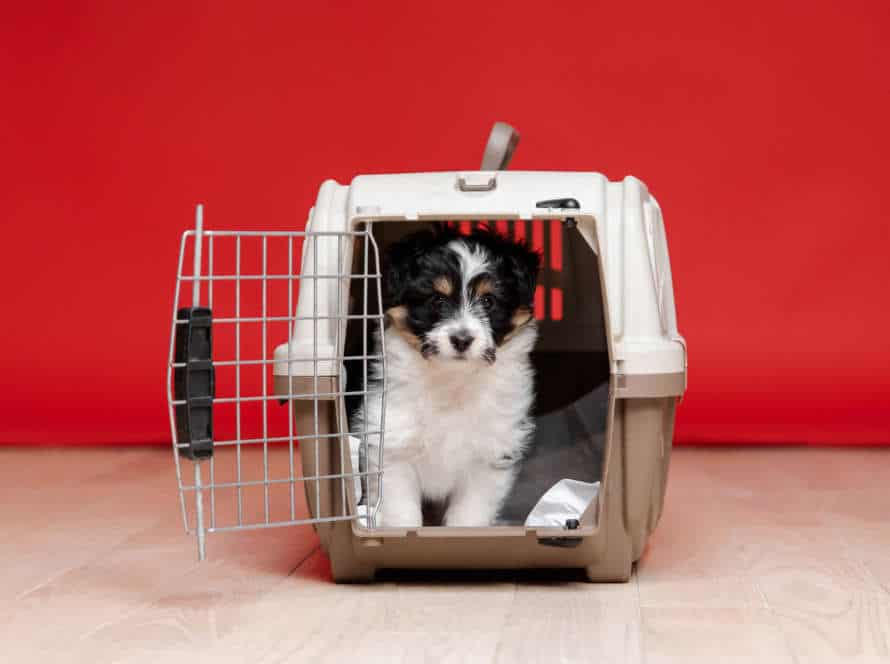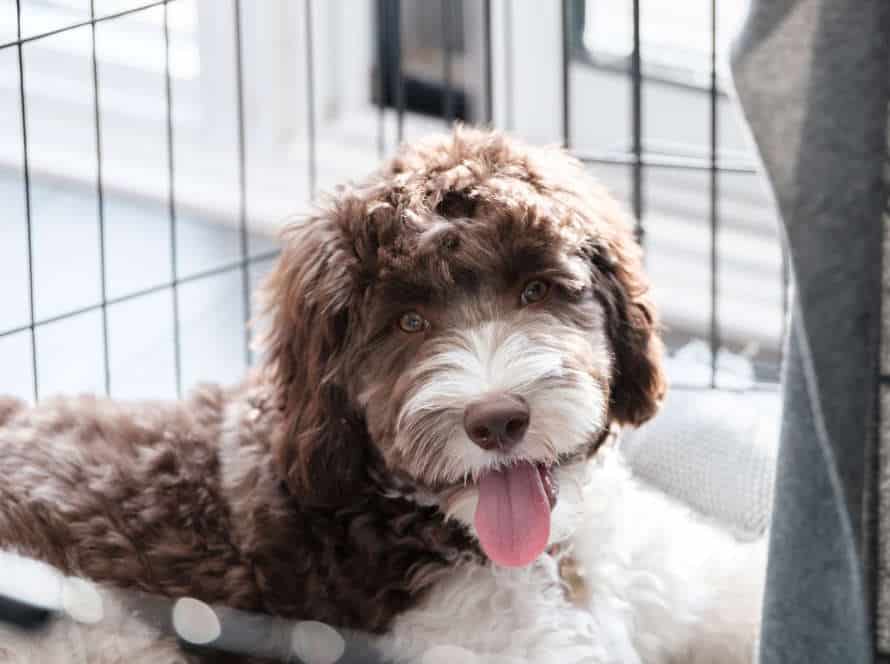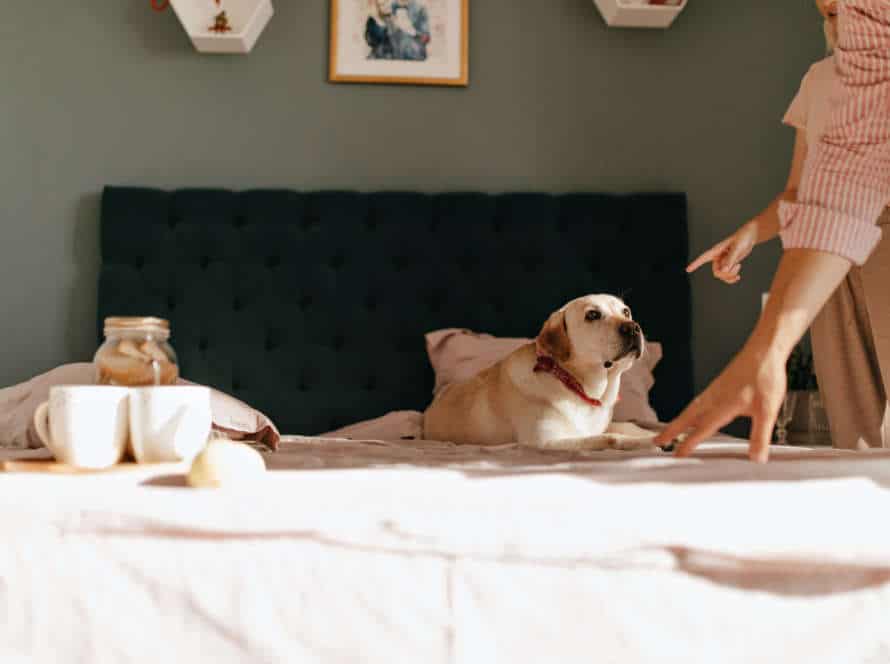Crates for Small, Medium, and Large Dogs: A Comparison
When picking crates for your pooch, you can find different options depending on their size and breed. Here’s a comparison of small, medium, and large dog crates.
Small Dog Crates: These typically measure 18-24 inches, ideal for small breeds like Chihuahuas or Yorkies. Lightweight and easy to transport.
Medium Dog Crates: 30-36 inches, for medium-sized breeds such as Beagles, Corgis, or Bulldogs. Offering more comfort than small crates but still movable.
Large Dog Crates: 42-48 inches, perfect for bigger breeds like Labradors or German Shepherds. Made with stronger materials to hold the weight and movement of large dogs.
Be sure to choose a crate that’s comfortable, secure and spacious enough for your pet to move around.
Types of Dog Crates
Dog crates: essential for our pup’s safety and comfort. Different types may be better suited for different dog sizes. A crate may not fit a certain breed. Let’s compare types and discover which is best for small, medium, and large dogs.
Plastic Dog Crates
Plastic dog crates are a great choice for pet owners. They are durable, affordable and easy to use. It’s essential to select the right size for your pup’s breed and size. Let’s look at how plastic crates compare for small, medium, and large dogs.
Small Plastic Dog Crates: Perfect for pups up to 25lbs. Compact design and single-lock system. Ideal for small apartments, car trips and short journeys.
Medium Plastic Dog Crates: Suitable for dogs up to 50lbs. Extra room compared to the smaller ones. Good ventilation and double-lock system for safety.
Large Plastic Dog Crates: For dogs up to 90lbs. More space, ventilation and sturdiness. Some have wheels for easier mobility. But they take up lots of space, so not great for small apartments.
Pro Tip: Measure your pup’s height and length. Pick a crate that is roomy enough to move around in. Always double-check the locking system.
Wire Dog Crates
Wire dog crates are a great choice for pet owners who want a long-lasting and safe place for their pets. Different sizes and types are available for small, medium, and large dogs.
Types of wire dog crates:
- Heavy-Duty Wire Crates: Made of strong steel. Perfect for escape artists or destructive doggos.
- Soft-Sided Wire Crates: Lightweight and easy to move. Made of fabric and mesh.
- Foldable Wire Crates: Great for travelling pet owners. Lightweight and easy to store.
Comparison of crates for small, medium, and large dogs:
- Small Dogs: Soft-sided and foldable crates are ideal. Cozy and secure. Easy to transport.
- Medium Dogs: Heavy-duty and foldable crates offer enough space and security.
- Large Dogs: Heavy-duty wire crates give the most space. Durable and secure.
Wire dog crates provide a variety of options for all your needs. Perfect for travel or a permanent home.
Soft-sided Dog Crates
Soft-sided dog crates are great for pet owners who want a comfy, secure spot for their pooch. Plus, they come in various sizes for small, medium, and large breeds.
Let’s compare the types of dog crates available:
- Plastic crates – strong, durable, easy to clean, and provide good air flow. But they can be tough to move around.
- Wire crates – lightweight, foldable, and great air flow and visibility. Not ideal for anxious or aggressive doggos.
- Soft-sided crates – the most portable, lightweight, and easy to store. Perfect for short trips and most airlines accept them in cabins. Not ideal for dogs that chew or scratch lots.
Choose the right crate for your pup’s travel-friendly, comfy stay.
Selecting the Right Crate for Your Dog
It is imperative to have a correct crate for your pooch. Not only should it be spacious and secure, but it also needs to be the right size and kind. Crates come in three sizes: small, medium, and large. Each has its own special features. To guarantee the right fit for your pup, let us look at the features of each size of crate.
Crate Size Recommendations
Choosing the perfect crate for your pup is key! Size matters when it comes to providing comfort and safety. The size of crate you select will depend on the breed and size of your doggo.
Small breeds, like Chihuahuas and Shih Tzus, require crates that are 18″ to 22″ long and 12″ to 16″ wide. This provides enough room for your small pup to move about.
Medium-sized pooches, such as Bulldogs and Cocker Spaniels, will need crates 28″ to 32″ long and 18″ to 24″ wide. This allows them to stand up and turn around comfortably.
Large dogs, such as Great Danes and Mastiffs, require crates 42″ to 48″ long and 28″ to 30″ wide. This gives them enough space to move around and stretch out.
Remember, the crate should be big enough for your dog to be comfortable, but not so big that they use it as a restroom.
Pro tip: A crate should be used as a training tool and a place of comfort for your dog, not as a punishment tool.
Material Considerations
When selecting a crate for your pup, size, nature, and needs must be taken into account – plus, the material of the crate. Here’s a comparison of crate materials for small, medium, and big dogs:
- Plastic: Lightweight, durable and easy to clean. Offers privacy and security. Good for dogs who like to hide or need extra protection during travel.
- Wire: Well-ventilated. Allows for better visibility. Easy to fold and store. Suitable for large dogs who need plenty of air circulation. Good for dogs with anxiety or aggression since it provides better visibility and is less intimidating.
- Soft-Sided: Lightweight, portable, and easy to transport. Ideal for small dogs who need a cozy and comfortable space while travelling or staying outside temporarily.
No matter the type of crate material, make sure it’s well-ventilated, safe, and comfy for your pup.
How to Choose the Best Door Type
Choosing a crate for your dog can be tough; so many options! Here’s a comparison of small, medium and large crates to help you decide.
- Small: 24 inches or less. Good for dogs up to 25 pounds. Look for sturdy construction, easy-to-clean materials and comfy interior.
- Medium: 30-36 inches. Perfect for dogs up to 50 pounds. Check for dual doors, removable trays, and good ventilation.
- Large: 42-48 inches. Right for dogs up to 90 pounds. Get a secure latching system, strong materials, and a removable divider.
Remember: measure your pup and consider their behavior when selecting the crate.
Features to Look for in a Dog Crate
Seeking a great dog crate? Features matter! It’s essential to select the right size for your pup. Plus, security, comfort, and ease-of-use are key. This article will compare crates for small, medium, and large dogs. Let’s find the best one for your furry friend!
Portability and Storage
Picking the right dog crate is key! There are several features to consider. Look for something lightweight and collapsible, so it’s easy to store and transport. Choose materials that are durable and can handle your pup’s chewing and scratching. Removable and washable crate pads and covers make for easier cleaning.
Secure doors that open easily for feeding and interaction are a must. And make sure there’s adequate ventilation for good airflow. Plus, if you plan on travelling or going outdoors, make sure your crate has a handle for easy carrying. By keeping these things in mind, you’ll find a crate that fits your pup’s needs – and yours too!
Cleaning and Maintenance
When it comes to dog crates, cleaning and maintenance are essential for your pup’s health and safety. Here are some tips:
- Use mild soap and warm water to wash the crate, especially if there have been accidents.
- For tough stains and odors, use pet-friendly cleanser or a vinegar/water mix.
- Dry the crate completely to avoid mould and bacteria.
- Check it often for damage or wear, like rust, loose bolts, or sharp edges.
- Look for these features when shopping: size, ventilation, secure latches, removable trays, comfy and sturdy construction.
- Small, medium, and large crates offer different benefits based on your dog’s needs, such as mobility, comfort, and security.
Safety and Security
When picking a crate for your pet, safety and security should be your number one priority. Here are the key features to look for so your furry friend is secure:
- Size: Your pup should be able to stand, turn around, and lie down comfortably in the crate.
- Material: Pick a crate made of strong, non-toxic materials, with locks on the door.
- Ventilation: Choose one with adequate ventilation to let air circulate and stop your pup from getting too hot.
- Cleaning: Get a crate with a removable, washable bottom tray.
- Portability: If you need to transport your pup often, get a lightweight, collapsible crate.
- Compatibility: Make sure the crate is compatible with your dog’s behaviour and needs.
By keeping these features in mind, you can choose the ideal crate for your dog, based on their size and their individual needs.
Pros and Cons of Popular Dog Crate Brands
The right crate is essential for creating the ideal space for your pup. Varied brands are available, each having its own pros and cons. In this article, we’ll look into the benefits and drawbacks of some of the most famous dog crate brands, suitable for small, medium and large breeds.
Frisco Dog Crates
Frisco dog crates are perfect for pet owners seeking a rugged and inexpensive crate for their fur-babies. They come in different sizes, suitable for small, medium, and large dogs.
Pros:
- Cost-effective: Frisco dog crates cost less than other brands, an economical option.
- Durable: Made from robust materials, these crates can last and endure wear and tear.
- Varied: Frisco dog crates come in different sizes and styles, giving pet parents lots of options.
Cons:
- Fewer features: Unlike other dog crates, Frisco dog crates don’t have built-in wheels, detachable roofs, or elevated beds.
- Assembly may be necessary: Some Frisco dog crates need to be put together, which could be tricky for pet parents not good with tools.
Despite these cons, Frisco dog crates remain a great choice for pet parents seeking a reliable and affordable crate for their fur-babies.
Petmate Dog Crates
Petmate dog crates are a popular choice for pet owners. They have pros and cons to consider. Pros include: Durable construction, different sizes, easy to clean, and secure latches. Cons include: Heavy and bulky, price, and noisy.
Pro tip: Look at size, weight, lifestyle, and budget when choosing a Petmate crate or any other brand.
Midwest Dog Crates
Midwest Dog Crates are a popular choice for pet owners – but there are pros and cons to consider before buying.
Pros:
- Quality materials make them durable and long-lasting.
- Wide range of sizes – from small to large – suitable for all breeds.
- Removable plastic tray for easy cleaning and maintenance.
Cons:
- Expensive compared to other brands.
- Heavier and bulkier than others.
- Door latch can be tricky to secure.
Overall, Midwest Dog Crates are a reliable choice. It’s important to weigh the pros and cons and see if they’re right for you and your pup.
Training Tips for Crate Use
Crate training your pup is a must. Size matters – pick the right crate size for your doggy. In this article, we’ll compare crates for small, mid-sized and large breeds. Plus, we’ll give you some training tips to get the best out of your pup’s new home.
Introduction to Crate Training
Crate training can be a great way to give your pup independence while keeping them safe. Here are some tips to get the most out of it:
- Introduce the crate gradually, use positive reinforcement.
- Choose a crate that fits your pup’s size and breed – enough space to stand, turn around and relax.
- Don’t use it as punishment or leave pup in there for too long – it can cause stress.
- Provide exercise and playtime outside the crate, to keep pup physically and mentally healthy.
- Make it comfy with bedding and toys.
When it comes to size, small crates for toy breeds and puppies, medium for small-medium dogs, and large for larger breeds. Pick the right size for your pup’s safety and comfort.
Crate Training Dos and Don’ts
Crate training can be a handy tool for pet owners. Here are some dos and don’ts you should know.
- Dos:
- Introduce your pet to the crate gradually, starting with short periods.
- Provide a comfy bed or blanket.
- Reward your pet with treats and praise for entering and staying in the crate.
- Use the crate as a safe and secure spot, not as punishment.
- Don’ts:
- Leave your pet in the crate for too long.
- Use the crate as punishment.
- Use the crate to replace quality time with your pet.
Pro tip: Consider your pet’s size and growth potential when choosing a crate. This’ll ensure maximum comfort and durability.
Troubleshooting Common Crate Training Problems
Crate training your pup can be rewarding, but it’s not always easy. If you’re having issues, try these tips:
- Problem: Your dog whines, barks, and acts anxious when left in the crate.
Solution: Give them treats and toys and gradually increase their time in the crate. - Problem: Your dog won’t enter the crate.
Solution: Make it comfy with blankets and toys. Also, check the size is right. - Problem: Your dog soils the crate.
Solution: Take them out to the bathroom before putting them in. Clean and sanitize the crate after each use.
By tackling these common crate training problems, you and your pup can have a much better experience!
Frequently Asked Questions
1. Q: What is the difference between a small dog crate and a large dog crate?
A: Small dog crates are designed to accommodate dogs that weigh less than 30 pounds, while large dog crates are suitable for dogs that weigh over 70 pounds. The size of the crate determines the comfort and safety of the dog.
2. Q: Can I use a medium-sized crate for my large dog?
A: It is not advisable to use a medium-sized crate for a large dog. A large dog needs adequate space to stretch and move inside the crate, and a medium-sized crate may be too small for the dog, causing discomfort and even injuries.
3. Q: What materials are used to make dog crates?
A: Dog crates are made of different materials, including metal, plastic, and wire. Metal and wire dog crates are sturdy and durable, while plastic crates are lightweight and easy to clean.
4. Q: Can I use a soft-sided crate for my dog?
A: Soft-sided crates are suitable for small dogs and dogs that are not aggressive chewers. They are lightweight and easy to transport, but may not be as sturdy as metal or plastic crates.
5. Q: How do I choose the right size crate for my dog?
A: To choose the right size crate for your dog, measure your dog’s height and length and add a few inches to each dimension to ensure that the dog has enough space to move and stretch inside the crate.
6. Q: Is it important to crate train my dog?
A: Yes, crate training is important for dogs as it can provide a safe and secure place for them to rest and relax. It can also help with potty training and prevent destructive behaviors when you are not at home.







